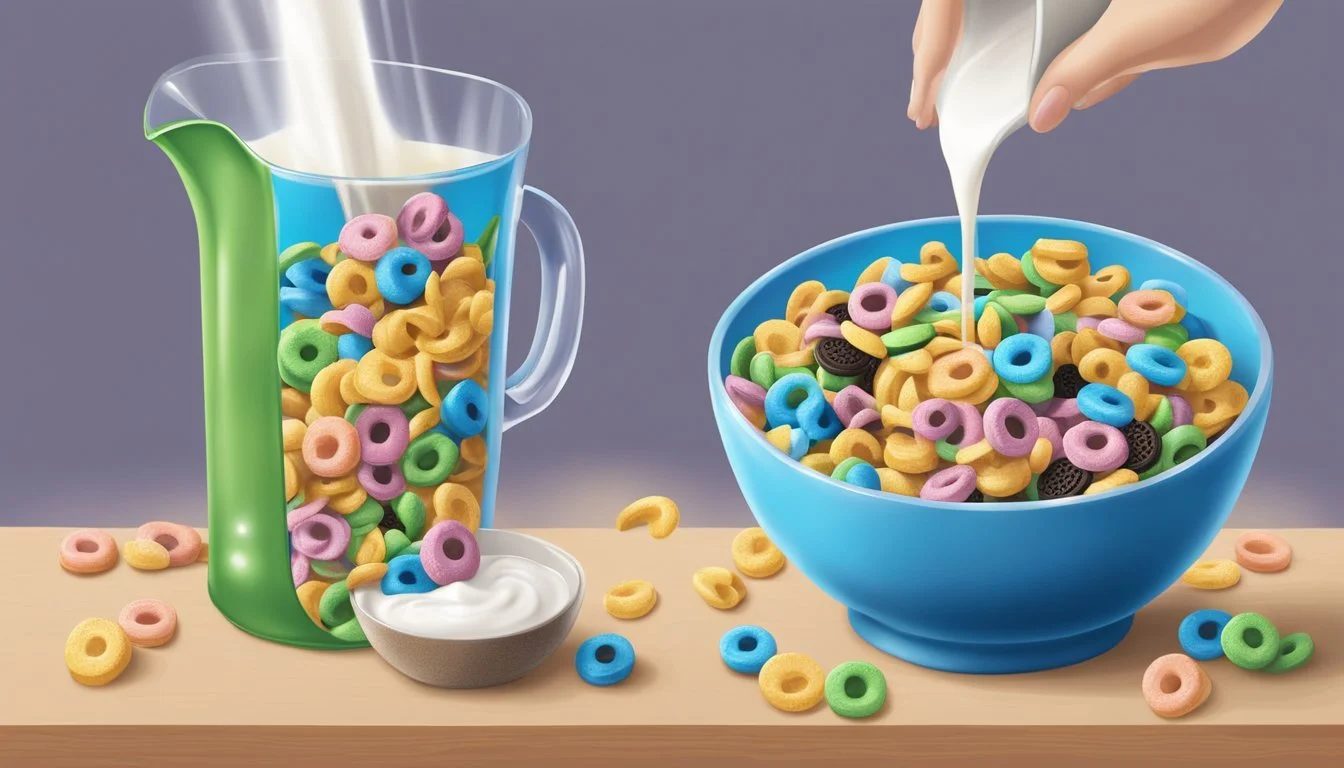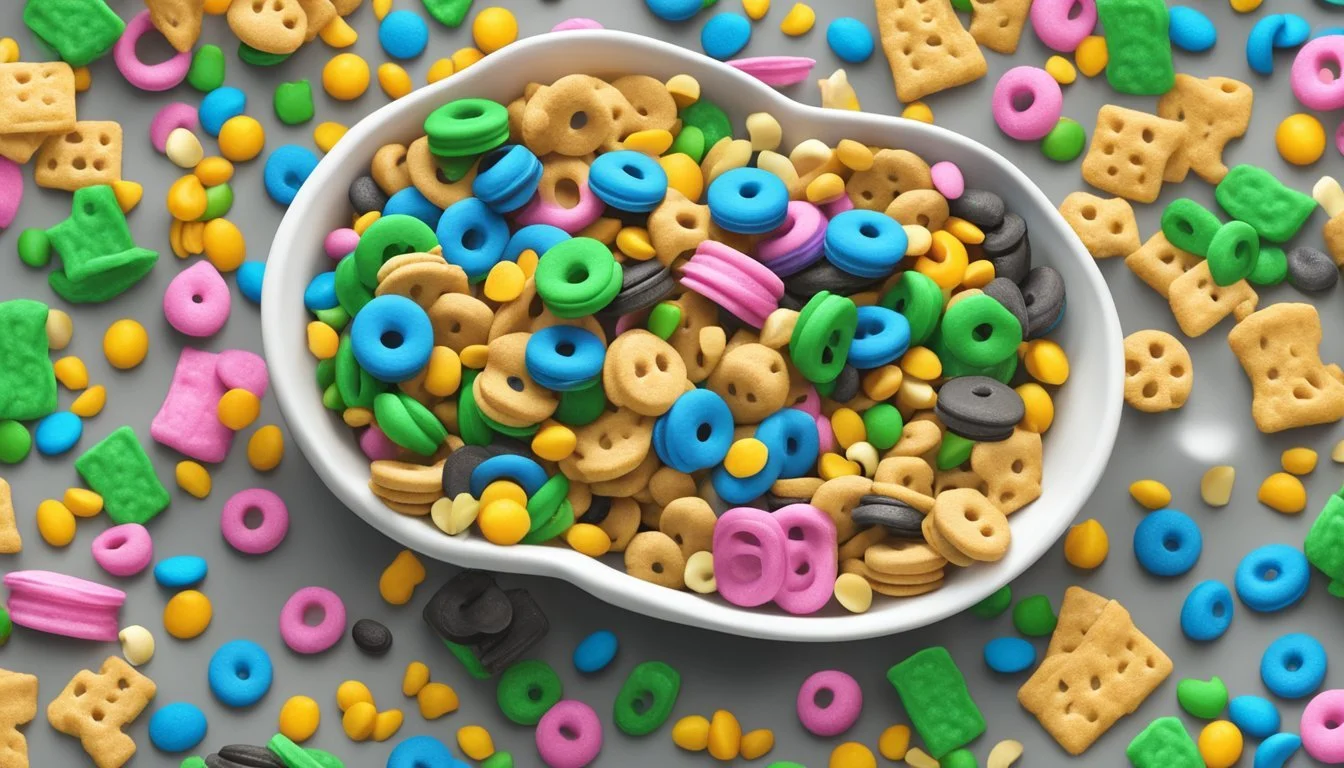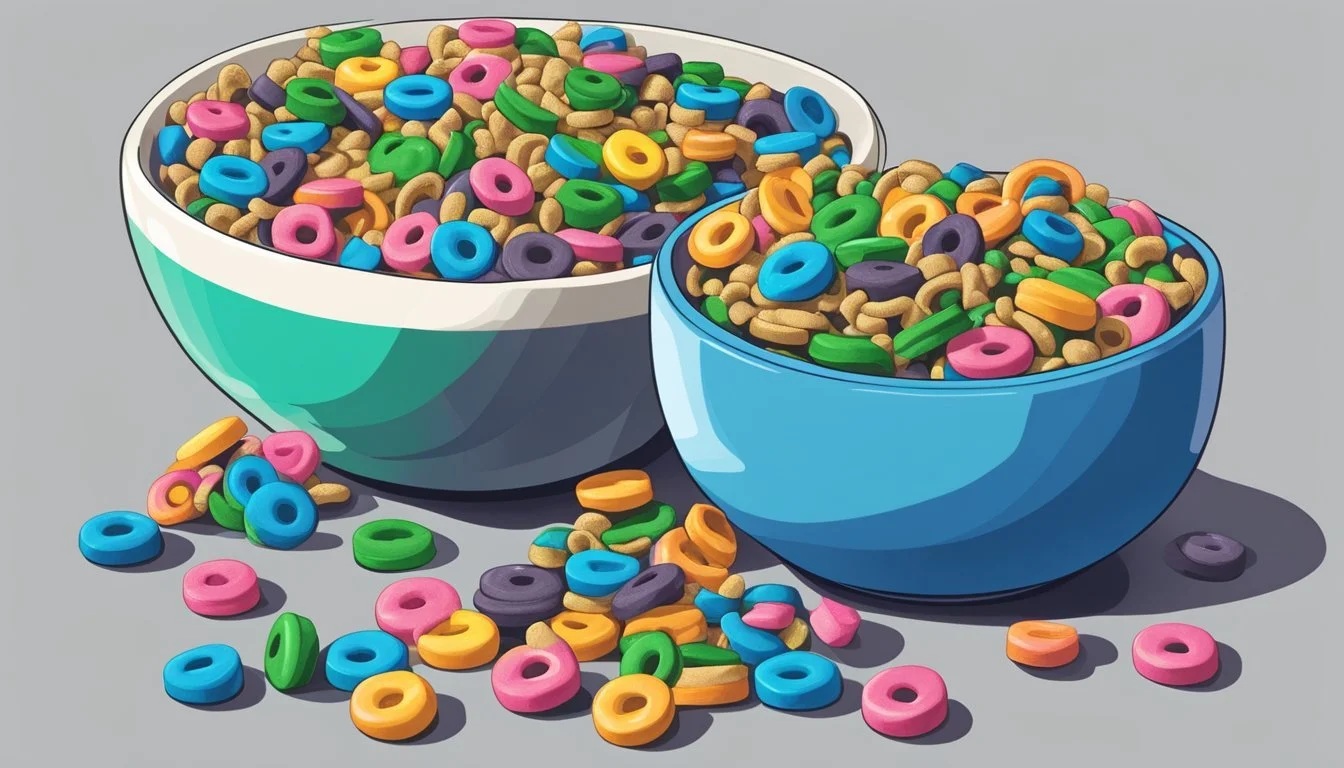Lucky Charms vs Oreo O's
Comparing Breakfast Cereal Favorites
This Article is Part of Our Breakfast Cereal Guide with Details on Lucky Charms Nutrition and Oreo O's Nutrition
When it comes to breakfast cereals, two popular choices that often spark debate are Lucky Charms and Oreo O's. Both are beloved by cereal enthusiasts, each offering its unique charm and flavor profile. Lucky Charms have been a staple in grocery stores for decades, known for their colorful marshmallows and lightly sweetened oats.
Oreo O's, on the other hand, have made a strong comeback in recent years, appealing to those with a penchant for dessert-like breakfasts. For those wondering which cereal suits their breakfast table better, the choice boils down to a preference for marshmallow-filled delight versus the rich, chocolatey crunch. Each has its nutritional pros and cons, making the decision a matter of taste and health considerations.
Exploring these cereals reveals much about consumer preferences in the breakfast aisle. Lucky Charms continue to capture the nostalgic joy of childhood mornings, while Oreo O's bring an indulgent twist to the morning routine.
History and Development
Lucky Charms and Oreo O's are iconic cereals that bring back memories for many. Each cereal has a unique origin and development trajectory shaped by innovative minds and responses to market demand.
Origins of Lucky Charms
Lucky Charms, introduced by General Mills in 1964, was a creative brainchild of product developer John Holahan. The cereal featured distinct shapes: bells, fish, arrowheads, clovers, and x-shaped oat pieces with vibrant marshmallows in green clovers, pink hearts, orange stars, and yellow moons.
These marshmallows, also called "marbits," became the primary attraction for children and adults alike. The mascot, a leprechaun named Lucky, was central to its marketing strategy, adding a whimsical charm to the cereal aisle. Over the years, new marshmallow shapes and limited editions kept the brand fresh while maintaining its nostalgia.
The Creation of Oreo O's
Oreo O's were launched by Post in 1998, inspired by the beloved Oreo cookie. It quickly became a favorite among childhood cereals due to its distinct blend of chocolate flavor with a hint of that signature Oreo cream taste. The cereal was designed as ring-shaped, crunchy pieces resembling mini Oreos, making breakfast exciting for fans of the cookie.
Despite its initial success, Oreo O's disappeared from shelves in 2007 due to a split in licensing agreements between Post and Kraft Foods. The cereal saw a resurgence in 2017, allowing it to reclaim a spot in the hearts of nostalgic fans who had missed the unique taste.
Nutritional Comparison
Lucky Charms and Oreo O's are popular breakfast cereals that differ significantly in nutritional content. This section examines their sugar content, essential nutrients, whole grain and fiber, and additives.
Sugar Content Analysis
Lucky Charms contain 11 grams of sugar per serving. This cereal's high sugar content stems from both the cereal pieces and marshmallows.
Oreo O's have 13 grams of sugar per serving, primarily added sugar.
Reducing sugar intake is vital, making Lucky Charms a slightly better option, though both are high in sugar.
Cereal Sugar per Serving Lucky Charms 11 grams Oreo O's 13 grams
Essential Nutrients and Vitamins
Lucky Charms boast several essential nutrients, including Vitamin B6 and Iron. They contain 25% of the daily value for Vitamin B6 and 50% for Iron.
Oreo O's are also fortified with vitamins and minerals but provide less Iron and Vitamin B6 compared to Lucky Charms.
In terms of key nutrients, Lucky Charms are more nutrient-dense.
Whole Grain and Fiber Considerations
Whole grain intake is vital for a balanced diet. Lucky Charms contain whole grain oats as the first ingredient, contributing beneficial fiber. They have around 2 grams of fiber per serving.
Oreo O's primarily use refined grains and offer 0.5 grams of fiber per serving, making them less favorable for fiber and whole grain content.
Cereal Whole Grain Fiber per Serving Lucky Charms Yes 2 grams Oreo O's No 0.5 grams
Assessment of Additives and Preservatives
Lucky Charms use high fructose corn syrup and preservatives like BHT.
Oreo O's include artificial flavors and have preservatives as well, but lack high fructose corn syrup.
Despite both cereals having additives, Lucky Charms' use of high fructose corn syrup may be a deciding factor for those avoiding certain additives.
By analyzing sugar content, essential nutrients, whole grain and fiber, and additives, consumers can make informed choices between Lucky Charms and Oreo O's based on their dietary needs.
Flavor Profiles
Lucky Charms and Oreo O's offer distinct and memorable flavors, making them favorites among cereal enthusiasts. This section will provide a detailed comparison of taste and texture, as well as the variety of flavors available in each brand.
Comparison of Taste and Texture
Lucky Charms combine a mix of crunchy oat pieces with soft, sugary marshmallows. The marshmallows vary in shapes, adding a playful aspect to the eating experience. This balance of textures is a significant part of its charm.
Oreo O's aim to replicate the taste of Oreo cookies. The cereal pieces are crunchy, with a robust chocolate flavor and a hint of creaminess that mirrors the cookie's filling. The texture is consistent, offering a satisfying crunch in every bite.
Both cereals contrast with competitors like Cocoa Puffs and Cinnamon Toast Crunch. Cocoa Puffs provide intense chocolate without the creamy undertones, while Cinnamon Toast Crunch delivers a sweet and spicy experience with a crispy texture.
Chocolate Lucky Charms offer an alternative with chocolate-flavored oat pieces, blending the traditional Lucky Charms experience with a cocoa twist, somewhat bridging the gap between the two brands.
Variety of Flavors in Each Brand
Lucky Charms have primarily stuck to the original formula but have introduced variations like Chocolate Lucky Charms and Fruity Lucky Charms. These twists bring new dimensions to the flavor profile, offering chocolatey or fruity alternatives while maintaining the brand's signature marshmallows.
Oreo O's, on the other hand, mimic the variety seen in the Oreo cookie line, such as Chocolate Marshmallow and other limited edition spins. This variety keeps fans interested and caters to those who love trying new tastes.
In comparison to other brands, cereals like Frosted Flakes and Cocoa Pebbles offer fewer flavor variations. Frosted Flakes stick to their sweet corn foundation, while Cocoa Pebbles provide a consistent chocolate flavor similar to Cocoa Puffs, but with a distinct pebble texture.
Each brand's flavor offerings are designed to attract a diverse audience, ensuring there's something for everyone.
Market and Popularity Trends
Lucky Charms and Oreo O's both enjoy significant popularity in the cereal market, though their consumer bases and market trends differ notably. This section examines their sales, market adoption, and consumer preferences.
Sales and Consumer Preferences
Lucky Charms has a substantial presence in the U.S. cereal market. According to Euromonitor, it ranked as the 10th best-selling cereal in the country.
General Mills reports that a notable portion of its market, over 40%, consists of adult consumers.
This adoption highlights its broad appeal across age groups, partly due to its nostalgic appeal and sweet taste.
Oreo O's, relaunched by Post Consumer Brands, targets a younger demographic with a love for chocolate flavors.
Its reintroduction capitalized on the strong brand equity of Oreo cookies, quickly securing a loyal consumer base.
Both cereals maintain a strong online and retail presence, further driving their sales and market reach.
Health Considerations
Choosing a breakfast cereal should involve considering factors like sugar content, protein levels, and potential health benefits. The comparison between Lucky Charms and Oreo O's exemplifies the debate between what constitutes a healthy vs unhealthy cereal.
Healthy vs Unhealthy Cereal Debate
Healthy Cereal:
Typically emphasizes low sugar content and high protein.
Examples include whole grain cereals that offer sustained energy and reduce sugar crashes.
Unhealthy Cereal:
Often high in sugar and low in nutritional value.
Lucky Charms contains around 10g of sugar per serving with added colors and flavors.
Oreo O's present similar concerns with high sugar and low protein.
When choosing a cereal for a healthy breakfast, it's crucial to check labels for these key factors.
Consumer Experience
Lucky Charms and Oreo O's each bring unique elements to the table, affecting consumer choice through their design appeal and strategic marketing efforts.
Cereal Box Design and Appeal
The box design of Lucky Charms is deeply associated with its iconic leprechaun mascot and the vibrant rainbow colors that signify the marshmallow pieces inside. The prominent display of its slogan, "Magically Delicious," usually draws attention from both children and adults who grew up eating this childhood cereal.
Oreo O's, on the other hand, features a sophisticated design. The packaging emphasizes the cereal’s connection to the popular Oreo cookie, showcasing images of chocolatey O's and milk splashes. This design aims to invoke a sense of indulgence and craving in potential buyers.
Both cereals leverage bright, eye-catching colors and high-contrast design elements to stand out on supermarket shelves.
Influence of Mascots and Marketing
The Lucky Charms leprechaun has been a staple of its marketing campaign since the cereal's inception. This character, along with the tagline "They're Magically Delicious," resonates with consumers nostalgically. The consistent use of this mascot in advertisements has solidified the cereal’s brand identity and made it a familiar household name.
In contrast, Oreo O's does not have a specific mascot but relies heavily on the established brand recognition of Oreo cookies. Marketing for Oreo O's often focuses on the pleasure of blending a beloved snack into a breakfast cereal, targeting both children and adults who enjoy Oreos.
Thus, while Lucky Charms uses character-driven marketing, Oreo O's benefit from the strong legacy and widespread recognition of its parent product.
Environmental and Dietary Considerations
When choosing between Lucky Charms and Oreo O's, it's important to consider both environmental impacts and dietary aspects. This involves looking at organic and non-GMO options, as well as the broader ecological consequences of cereal production.
Organic and Non-GMO Options
Lucky Charms and Oreo O's both contain various ingredients, some of which may be natural, but neither is typically available in organic or non-GMO varieties.
Natural ingredients in both cereals include whole grains and sugars.
Neither product emphasizes organic certifications, nor do they specifically target a market concerned about preservatives or hydrogenated oils. Consumers looking for organic or non-GMO cereals might need to explore other brands, as these cereals prioritize flavor and brand recognition over these specific dietary considerations.
Impact of Cereal Production on Environment
The production of cereals like Lucky Charms and Oreo O's can have significant environmental impacts.
The cultivation of grains, sugar, and other ingredients requires substantial water usage, land, and energy. Additionally, packaging materials and transportation contribute to the ecological footprint.
According to studies, cereals with more natural or environmentally-friendly practices, such as minimal use of pesticides or adopting sustainable farming techniques, tend to have a lower environmental impact.
Consumers interested in sustainability might therefore prioritize cereals that emphasize these eco-friendly practices. Preservative use and the presence of hydrogenated oils also affect the sustainability of cereal production, with more natural recipes generally being more environmentally friendly.







